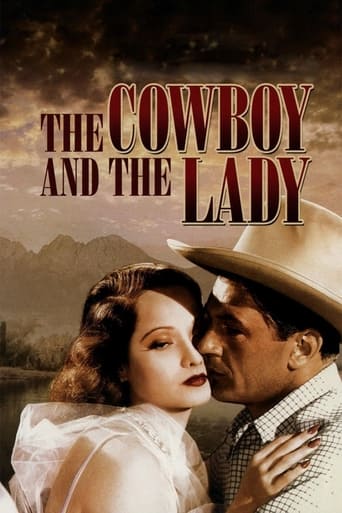Matialth
Good concept, poorly executed.
CrawlerChunky
In truth, there is barely enough story here to make a film.
Helloturia
I have absolutely never seen anything like this movie before. You have to see this movie.
Isbel
A terrific literary drama and character piece that shows how the process of creating art can be seen differently by those doing it and those looking at it from the outside.
JohnHowardReid
Copyright 30 November 1938 by Samuel Goldwyn. Released through United Artists. New York opening at the Radio City Music Hall, 24 November 1938 (ran 2 weeks). U.S. release: 17 November 1938. Australian release: 16 February 1939. 9 reels. 91 minutes.SYNOPSIS: Fun-loving heiress strings along a dumb but eager cowpoke who is unaware of her real identity.NOTES: Academy Award, Thomas Moulton (only) Sound Recording. Also nominated for Best Original Music Score (The Adventures of Robin Hood won); and Best Song (the title ditty) which was defeated by "Thanks For the Memory" from The Big Broadcast of 1938.Despite the raft of writers (see below) who concocted this disappointing fling, the plot is as predictable as the synopsis suggests, with characters and dialogue so vapid and inconsequential they do nothing but waste the talents of a fine cast. No amount of glossy window-dressing by director, photographer, art directors and music scorer can disguise the script's basic poverty of invention, its supremely unmemorable plot and dialogue. All it adds up to is an extremely dated romance whose comic overtones must have been judged feeble and uninspired even by the most indulgent 1938 audience. Writers included Anita Loos and John Emerson, Dorothy Parker and Alan Campbell as well as Frederick Lonsdale, Howard Estabrook, Robert Ardrey, Eddie Moran, Frank Ryan, Gene Fowler, Robert Riskin, and Richard Connell. Yes, they all worked on the script at one time or another. The film commenced shooting on 15 June 1938 with William Wyler directing. Three days later, he was replaced by Potter because Goldwyn thought Wyler was working too slowly. However, Potter himself left before finishing the movie (he had a prior commitment to direct "The Story of Vernon and Irene Castle"), so Stuart Heisler finished up. All these headaches, plus cast replacements (Henry Kolker for Thomas Mitchell, while roles originally set for David Niven and Benita Hume were eliminated) brought the negative cost up to an incredible $1.8 million. (Thanks to Alvin H. Marill in "Samuel Goldwyn Presents" — A. S. Barnes, 1976 — for these interesting facts.)
worldofgabby
I really loved this movie. Merle Oberon, who is not my favorite actress, was charming as the frustrated daughter of an ambitious, controlling politician. Gary Cooper, handsome as always, was less wooden than usual, and totally believable, and the supporting players all handled the witty dialog with ease and pleasure. Suspension of disbelief came easily, and although the ending was somewhat hurried, it did produce the desired amount of tears and surprise. One must remember when this movie was made (when FDR was president,) and the populist message manifests itself throughout. The dialog and cinematography were excellent, and despite the fact that the action was a bit hokey at times, both the cowboy and elite milieus were beautifully contrasted and the main characters' emotions sensitively handled.
irish23
Charming, predictable story of "class clash" so popular in Depression-era pictures. With no need to worry about plot, you can just sit back and enjoy the performances.Merle Oberon hits just the right chord as a polished socialite with a hidden practical side and a goofball sense of humor. Her English accent is a trifle thick even for the "everyone rich has an English accent" days, but her physical comedy brings her back down to earth. She outshines everyone else in the film, in my opinion.Gary Cooper plays Gary Cooper as usual, but there were two shots in particular where I saw thoughts and emotions played that were deeper and more well-rounded than his stock plays (his stock plays being: bashful, strong-n-silent, voice of the working class, and bewildered).The cast is rounded out nicely by some of the better character actors of the day and the action moves along briskly. As others have noted, there are definite echoes of "It Happened One Night" and "Mr Deeds Goes to Town" as well as "Meet John Doe." All three films are better than this one, but "The Cowboy and the Lady" remains unexpectedly sweet and winning. A lovely bit of fluff!
MartinHafer
Considering the film has Merle Oberon and Gary Cooper, it couldn't help but be watchable...and it certainly was. The problem for me, though, is that with these actors and a concept that was decent enough, the film's script sure didn't do much with this. Instead, it has some nice moments as well as some lulls.Perhaps it was just too much pawning off the idea of Merle Oberon with her exotic ways and accent as a rich lady in love with Cooper. While the idea of a society lady falling for a cowboy, Oberon just seems too distant and cold to make it all seem possible. I really think someone a little more "human" could have made this odd pairing work well. Oberon was a fine actress but I just don't think she was right for this film.Perhaps it was that once the two fell in love, the film just stagnated until near the end. They married and yet the film still had a long way to go and the middle just seemed like filler at times--particularly Cooper's pantomime sequence inside their new house.Whatever the reason, the film just seemed like an agreeable time-passer and nothing more. Inoffensive and just a tad bland. For a SLIGHTLY better variation of this same plot, try seeing the John Wayne and Jean Arthur film LADY TAKES A CHANCE--it has better chemistry and is just a better film in most respects.

